Highlights of Levengrove Park
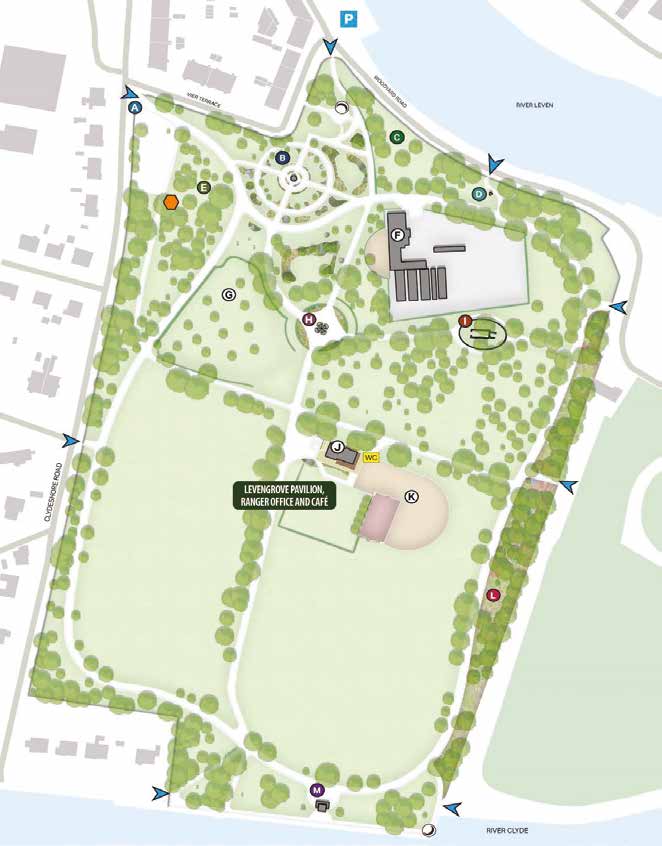
The Maple Garden, a collaboration between West Dunbartonshire Council Greenspace and HSCP, is an Additional Needs Play Area situated beside the training facility in Levengrove Park. The garden is now open for bookings.
Hourly slots available as follows:
Tuesday, Wednesday, Thursday: 10am – 4pm
To book your slot, please call 01389 737 467 or e-mail levengrove.events@west-dunbarton.gov.uk
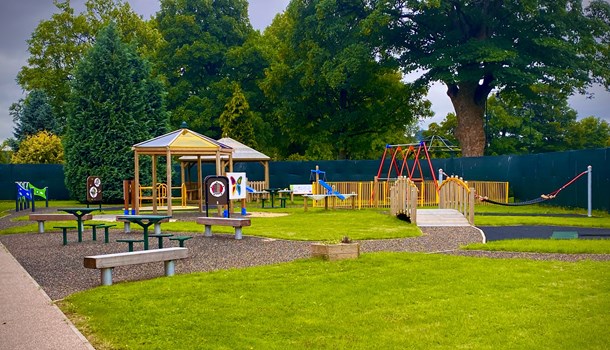
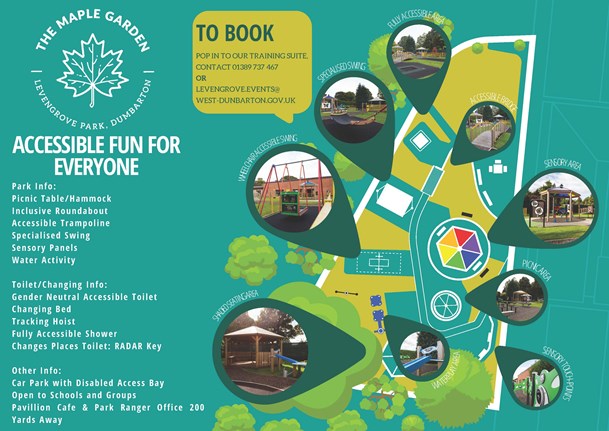
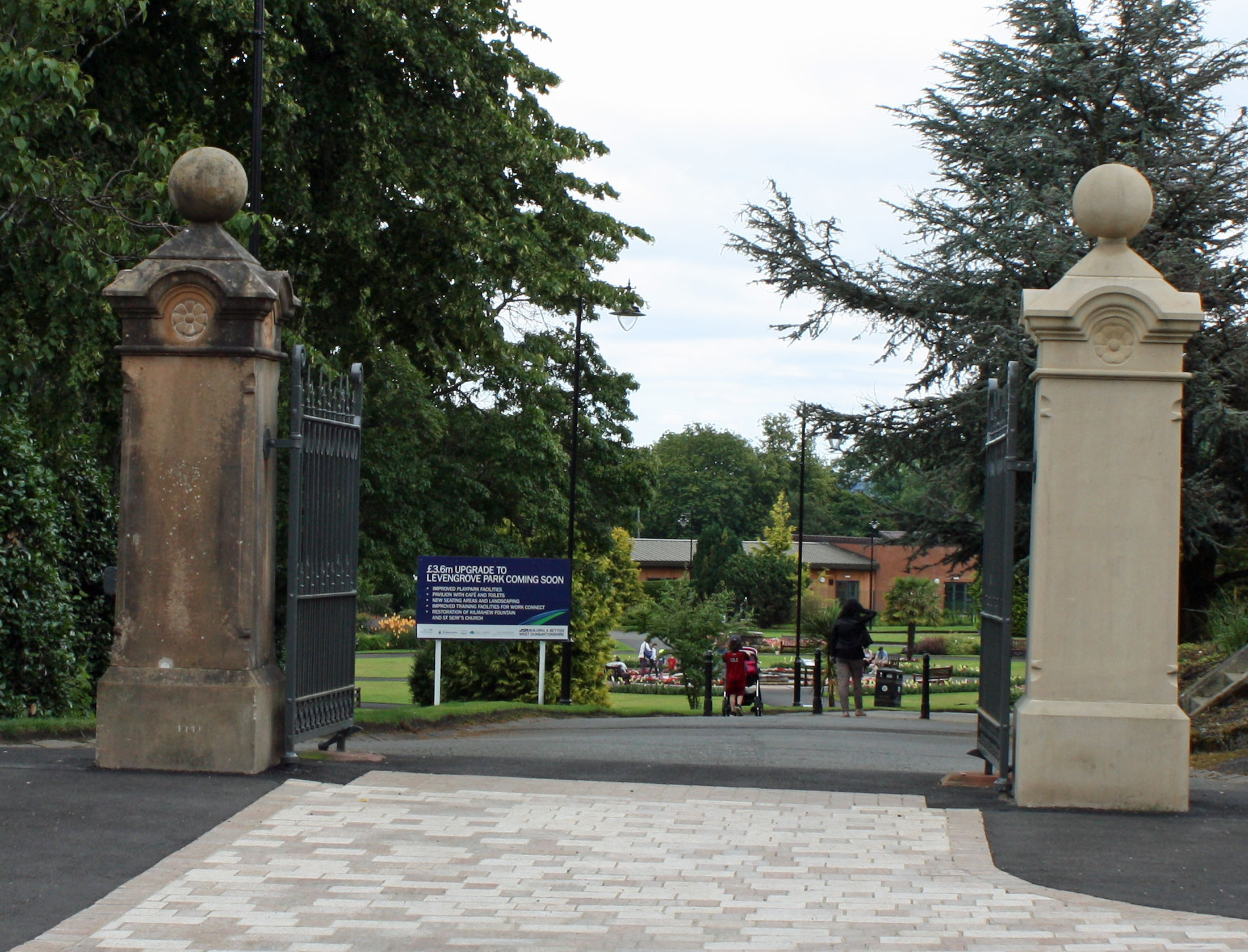 Historically, the lodge entrance formed the formal access to Levengrove Park. This entry to the park provides a grand sense of arrival, as visitors are afforded sweeping views down to the Kilmahew Fountain and towards Dumbarton Castle and the River Leven beyond.
Historically, the lodge entrance formed the formal access to Levengrove Park. This entry to the park provides a grand sense of arrival, as visitors are afforded sweeping views down to the Kilmahew Fountain and towards Dumbarton Castle and the River Leven beyond.
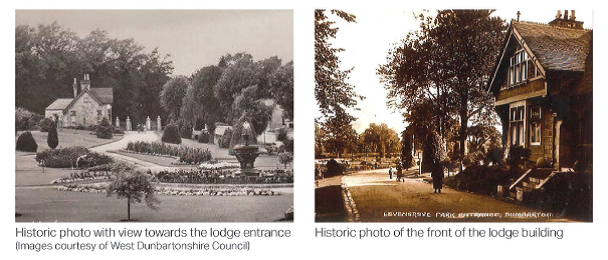
History
The lodge was designed by John MacLeod, a local Architect from Dumbarton. It was constructed by William Barlas in 1884 - 1885, prior to the grand opening of the park in 1885. The lodge is constructed in the Old English style, with half timbered gables, and includes a veranda to the front supported by three ornamental columns. A commemorative plaque, marking the opening of the park, is fixed to the corner of the lodge, it reads " Levengrove Park - Gifted to the inhabitants of Dumbarton by John McMillan and Peter Denny 1885."
The lodge was originally used as a house for the Park Keeper, but today the lodge and surrounding garden is a private residence.
The lodge entrance was originally formed of four square sandstone pillars with shaped caps and ball finials, intricate cast iron gates hung between the pillars, providing separate pedestrian and carriage entrances. The original gates were provided by A & J Main of Glasgow and were made using a combination of blacksmith techniques and castings.
The lodge building and gate pillars were designated as Category B Listed assets in 1984.
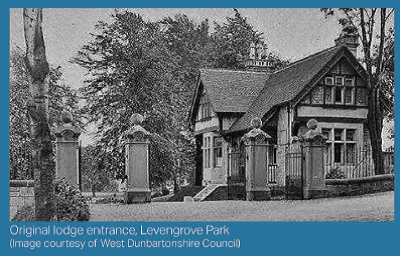
Restoration Process
Prior to the restoration, one of the four gate pillars was missing and another was twisted out of position. Although one pedestrian gate remained, the main vehicular gates and second pedestrian gate were missing. The restoration work has included;
- replacement of the missing sandstone pillar, which will weather over time to match the existing pillars;
- refurbishment and realignment of the three existing pillars;
- removal of then existing gate, which was then used to form a pattern for the creation of the new pedestrian and vehicular gates;
- refurbishment of the existing pedestrian gate, pintles and hinges and repainting;
- reinstatement of the missing ground catches in the cast iron; and
- introduction of high quality granite paving to enhance the sense of arrival.
 The Kilmahew Fountain is a locally significant feature which was relocated from Kilmahew House, near Cardross, the park in 1902. The fountain provides an attractive focal point to the north of the park and is set within flower beds.
The Kilmahew Fountain is a locally significant feature which was relocated from Kilmahew House, near Cardross, the park in 1902. The fountain provides an attractive focal point to the north of the park and is set within flower beds.
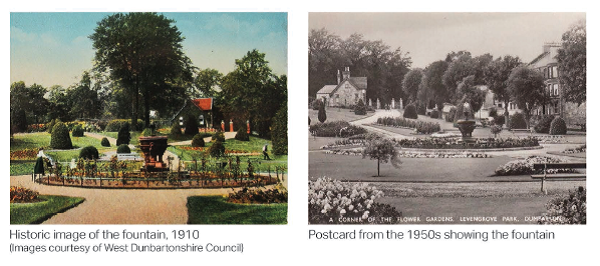
History
The Kilmahew Fountain was gifted to the Council in 1902 by Captain Burns of Kilmahew when the grounds of Kilmahew House were transferred to the Church to provide a site for St Peter's Seminary.
The Council procured cost estimates for the relocation of the fountain and Peter McNabb was appointed to conduct the work for the price of £17 and 10 shillings.
The Lennox Herald published an article on 26 April 1902 stating that the fountain:
"stands about seven feet high. The outer basin, which has a rim of freestone, is 19.5ft. in diameter, with concrete sides and bottom. Four ornamental vases cut in freestone stand on each side. The second basin is 11ft. in diameter and is constructed of white freestone, moulded. The third basin is 4ft. in diameter and is cut from a single block of freestone with the exception of the gargoyles, which are inserted...The Crown piece is in the shape of a feathery fern...8 down jets...and one upright jet which with mechanical appliances, can be used in a variety of ways...The whole design as we have said is handsome and the gift added a valuable feature to the park."
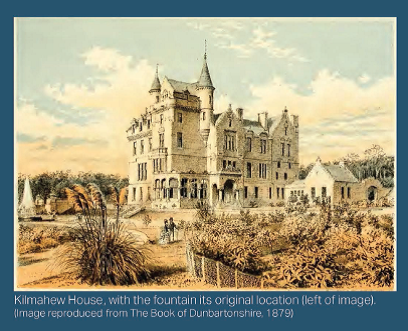
Restoration Process
The Kilmahew Fountain required extensive restoration due to the displaced stonework, missing and damaged features and severed pipework. Historically the fountain ran on a 'total loss' system, whereby water would only pass through the fountain once. A new recirculating water system has been installed.
Restoration work has included the:
- reforming of the upper centrepiece in granite;
- carving and installation of four new gargoyles in sandstone;
- refurbishment and repairs to the existing stonework;
- installation of a new pump and control system; and
- creation of a new sandstone path around the fountain.
The 1714 Well was discovered as the result of a tree falling during Storm Ali in September 2018. The fallen tree revealed a hidden well, which had been covered over by the tree. The exposed well is part of Dumbarton's first organised supply system to bring drinking water into the burgh from an outside source. The well dates back to 1714 and this is where it takes it's name.
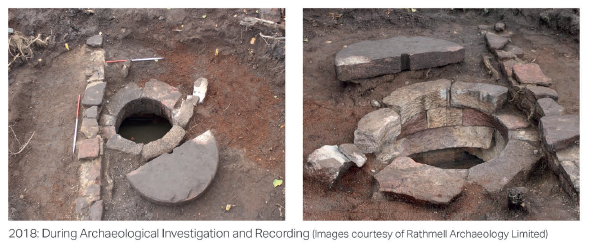
Restoration Process
Following the discovery, there have been several investigative works on this significant well. To preserve it's original stonework structure, the following works have been undertaken:
- Re-building damaged sections of the well and the adjacent wall using original stone from the site. Lime mortar was used above the finished ground level and cement mortar below ground level;
- Replacement of the semi-circular half complete stone cover;
- Creation of a new pedestrian access to the well from Woodyard Road; and
- Enhancement of the well's setting.
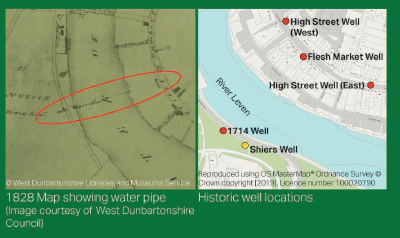
History
1713
"In consideration od the want of good water in the town, the Council resolve to convey St Shear's Well across the Leven."
This is the first recorded evidence of a municipal supply of clean water in Scotland and an important milestone in the creation of public services.
1714
In 1714 a lead pipe was laid on the bed of the River Leven to supply clean drinking water from the well to the town of Dumbarton. Mr Cairnby of Glasgow was appointed to carry out the work for the fee of £54. This lead pipe supplied a well at the Flesh Market and two other wells located at either end of the High Street, as shown above.
1860
The need for the water supply to Dumbarton from across the Leven was removed in 1860 when a gravity fed system was constructed, bringing water down from the hills.
2018
It was unclear exactly where the original water source for the town well was until 2018's Storm Ali blew over a tree (which had been there for over a hundred years) and revealed a previously unknown well dating to 1714.
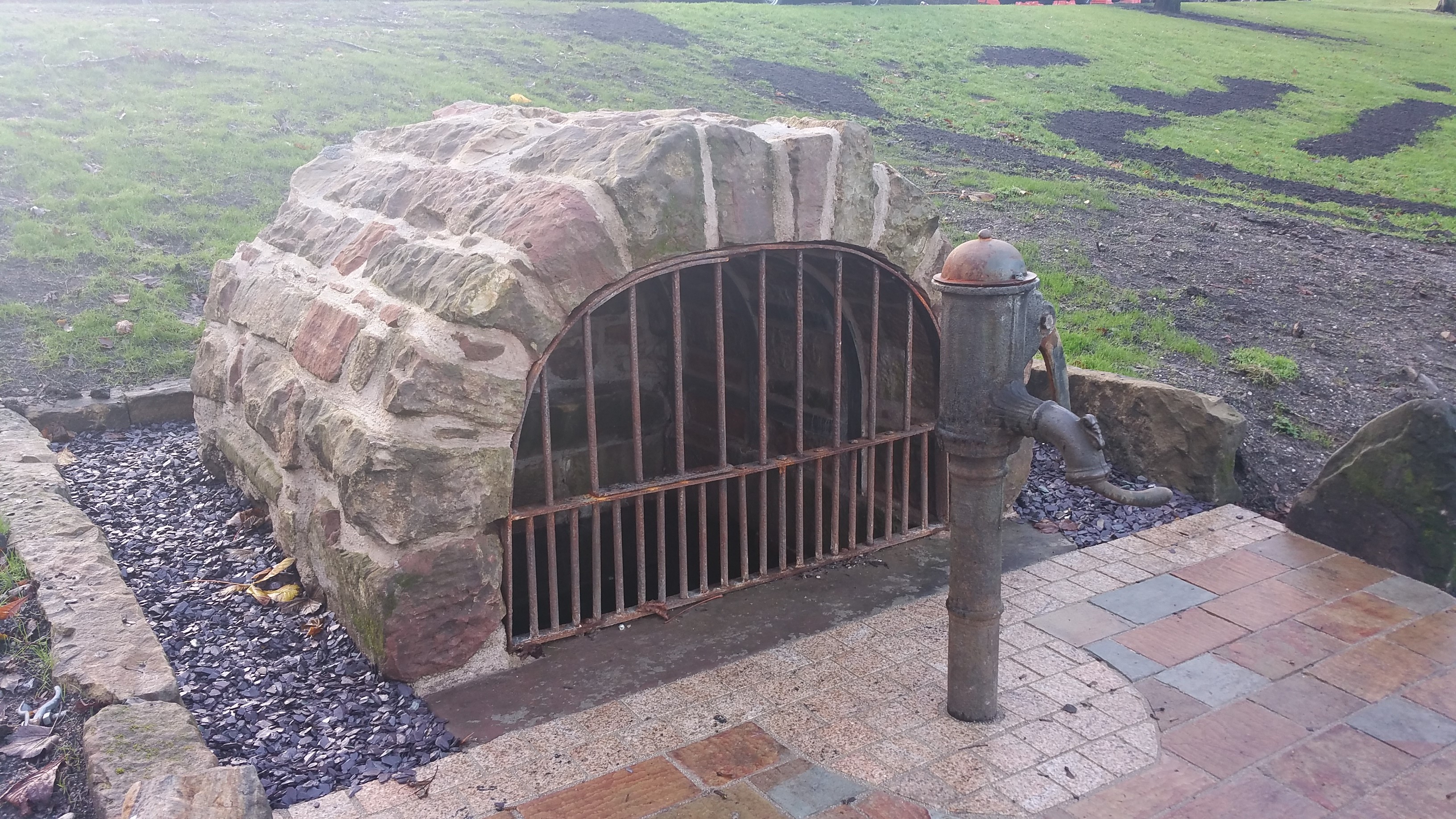 Shiers Well is an important historic feature of this area. Tradition suggests that it was a holy well, perhaps linked to the nearby St Serf's Church, which itself dates from before 1226 AD.
Shiers Well is an important historic feature of this area. Tradition suggests that it was a holy well, perhaps linked to the nearby St Serf's Church, which itself dates from before 1226 AD.
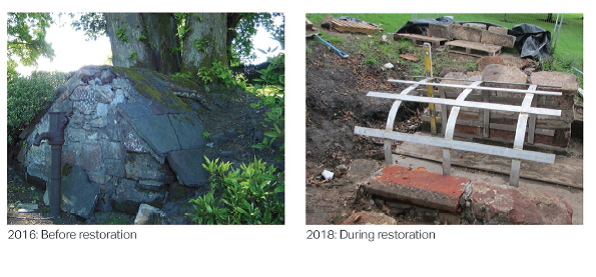
History
Early Medieval
The date of the well's origin is unknown, however it is thought to date back to medieval times. Shiers Well is traditionally associated with the same saint were located at Alva and Monzievaird. The well has been recorded under various names including: St Shear's Well, St Shier's Well and St Serf's Well.
1714
It is thought that both Shiers Well and the 1714 well, approximately 60m to the north of this location, are both supplied by the same natural aquifer. The wells were utilised as part of the water connection beneath the River Leven in 1714. This was part of the first municipal water supply in Scotland and you can find out more by visit the 1714 Well.
1891
An archaeological surveyor's note in the Canmore entry for St Serf's Church identified the well being used as a drinking fountain within the park. The original cast-iron pump in front of the well house was provided by George Smith and Sons of the Sun Foundry in Glasgow.
Restoration
Prior to restoration, Shiers Well have been covered and clad with a range of different materials, hiding the original stonework of the structure. To celebrate the significance of the well and highlight it's contribution to the park and historical importance to Dumbarton, the following works were undertaken;
- Removal of stone slab over-cladding and encroaching 3-stemmed lime tree;
- Restoration of the original stonework;
- Replacement of the missing hand pump and priming cover; and
- Enhancement of the path and well's setting.
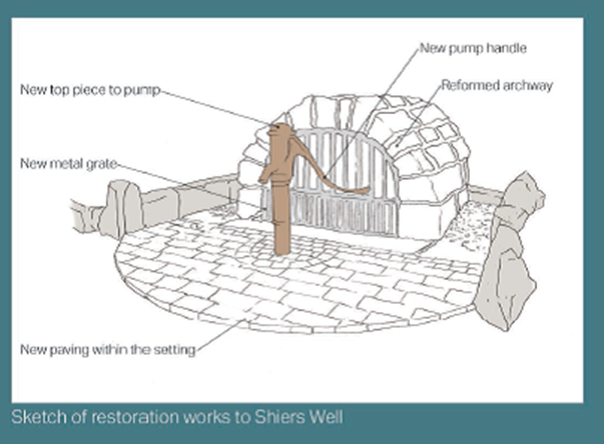
An Arboretum is similar to a botanical garden but contains a collection of trees, rather than other types of plants. In the UK, plant collecting became popular during the Victorian era, introducing exotic plants and trees into estates and gardens and leading to the creation of arboretums.
The Arboretum in Levengrove Park, was established by the Dixon family who owned Levengrove House and grounds between 1805 and 1884. The Dixon family travelled extensively and brought back many of the exotic trees which are still present today; including the tall Cedar of Lebanon and large Himalayan Cedar.
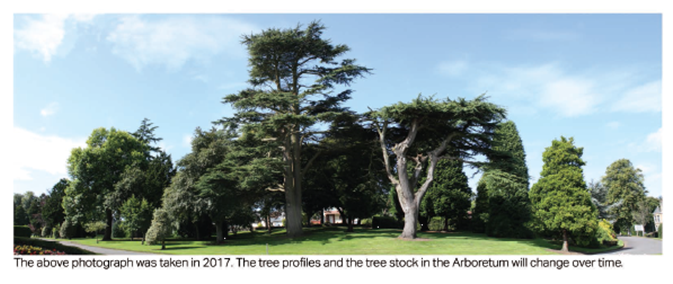
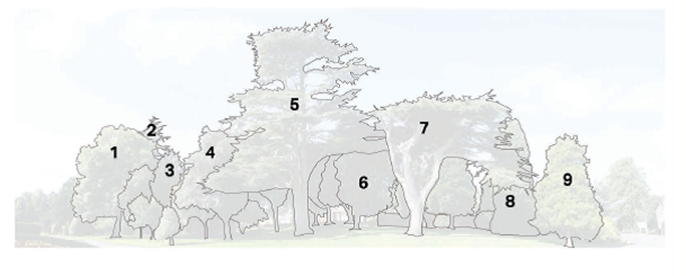
Tree Species
The Arboretum at Levengrove Park includes a range of exotic coniferous and deciduous trees, a few of which are described below, as show in the numbered image above.
1. Liriodendron tulipifera (Tulip Tree) - deciduous, native to eastern North America.
2 & 7. Cedrus deodara (Himalayan or Deodar Cedar) - Coniferous, native to the western Himalayas.
3, 6, 8 & 9. Chamaecyparis (Cypress or False Cypress) - Coniferous, native to eastern Asia and to the west and east margins of the United States.
4. Sorbus intermedia (Swedish Whitebeam) - Deciduous, native to southern Sweden and parts of Denmark, Finland, Estonia, Latvia and northern Poland.
5. Decrus libani (Cedar of Lebanon) - Coniferous, native to the mountains of the eastern Mediterranean, national emblem of Lebanon.
Work Connect Specialist Supported Employment Service
The Work Connect Specialist Supported Employment Service is part of West Dunbartonshire’s Health and Social Care Partnership (HSCP) and is based within the Training Suite in Levengrove park. Their main focus is horticulture and skills development, which supports service users to realise their potential in a supported environment that provides the opportunity to gain a range of real-life employability and life skills. This facility is also well used by community support groups to allow them to engage in gardening and in designing and develop their own plots.
This specialist service also provides clients and other service users with other activities which enhance interpersonal skills, confidence
and personal growth.
The Friends of Levengrove Park group base their activities in the park and volunteer their time assisting with various activities including managing and maintaining the Community Orchard and the War Memorial Garden.
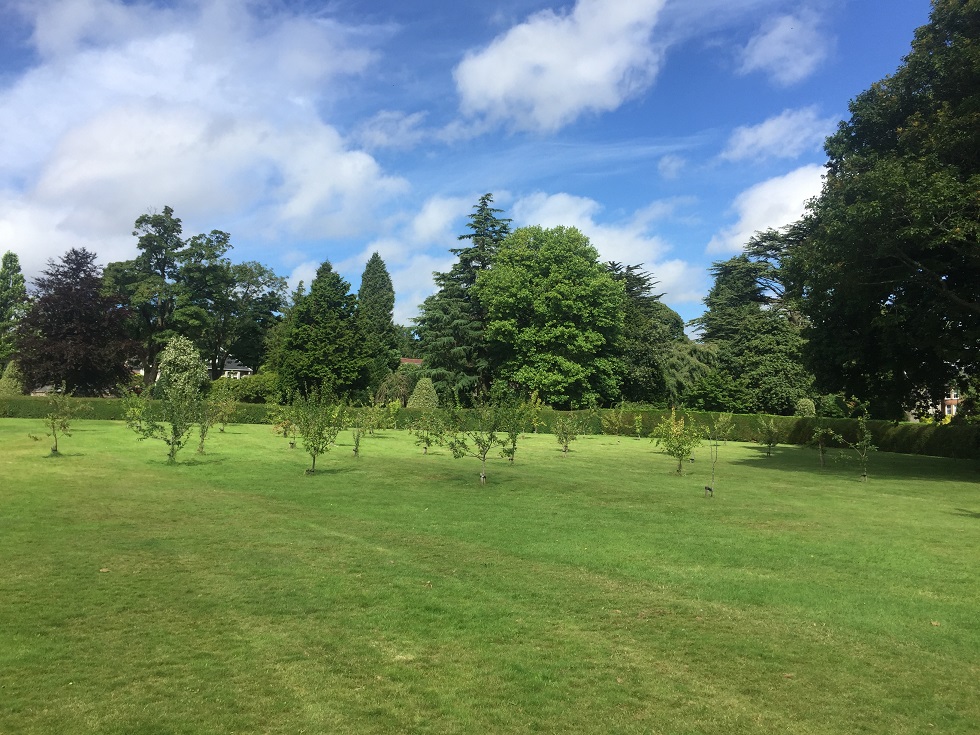
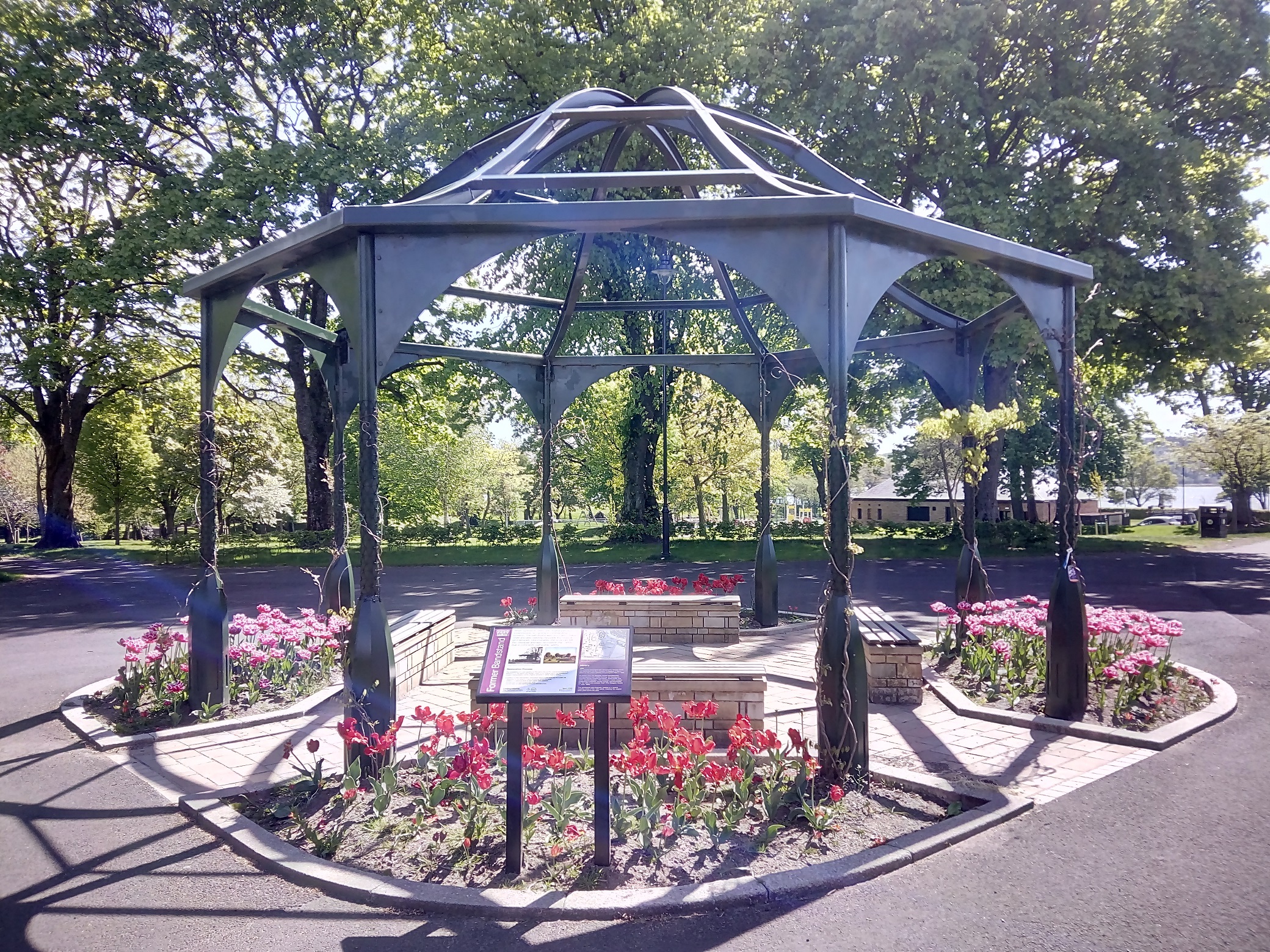 When opened in 1885, the original park feature a bandstand, occupying a commanding position. The bandstand was of a Franco-Italian style and was used by the public for musical promenades. Unfortunately, the structure fell into disrepair and was removed in the 1960's due to concerns over public safety.
When opened in 1885, the original park feature a bandstand, occupying a commanding position. The bandstand was of a Franco-Italian style and was used by the public for musical promenades. Unfortunately, the structure fell into disrepair and was removed in the 1960's due to concerns over public safety.
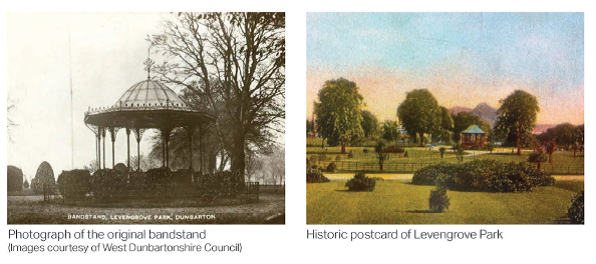
History
1885
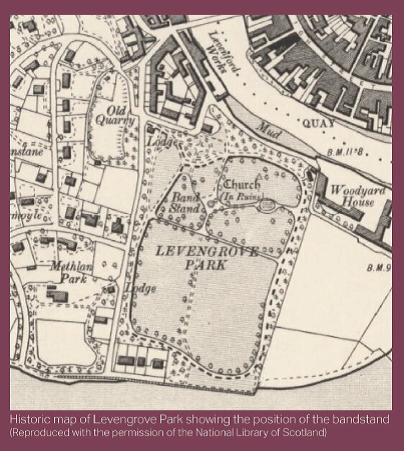 The original bandstand was designed by George Smith and Sons from the Sun Foundry in Glasgow. It was in place for the grand opening of Levengrove Park in 1885.
The original bandstand was designed by George Smith and Sons from the Sun Foundry in Glasgow. It was in place for the grand opening of Levengrove Park in 1885.
An article from the Glasgow Herald recorded that the bandstand had, "wood flooring, ten handsome columns having ornamental bases, spiral shafts and richly foliated capitals... The covering is dome shaped, presenting a graceful, curved outline, and terminates the top with a very suitable finial." (The Glasgow Herald, 1 June 1885)
The bandstand was originally located at a central meeting place of the main paths, creating the original focal point within the park.
Restoration Process
The installation of a new gazebo on the same site as the original bandstand is testament to the layout and design intent of the original park. The gazebo is a modern interpretation of the original bandstand rather than a replica.
In addition to the new gazebo, restoration work in this area has included the:
- reduction in the extent of hard surfacing within the area;
- addition of planting beds to add colour and interest;
- introduction of new hedgerows; and
- introduction of new lighting columns and benches.
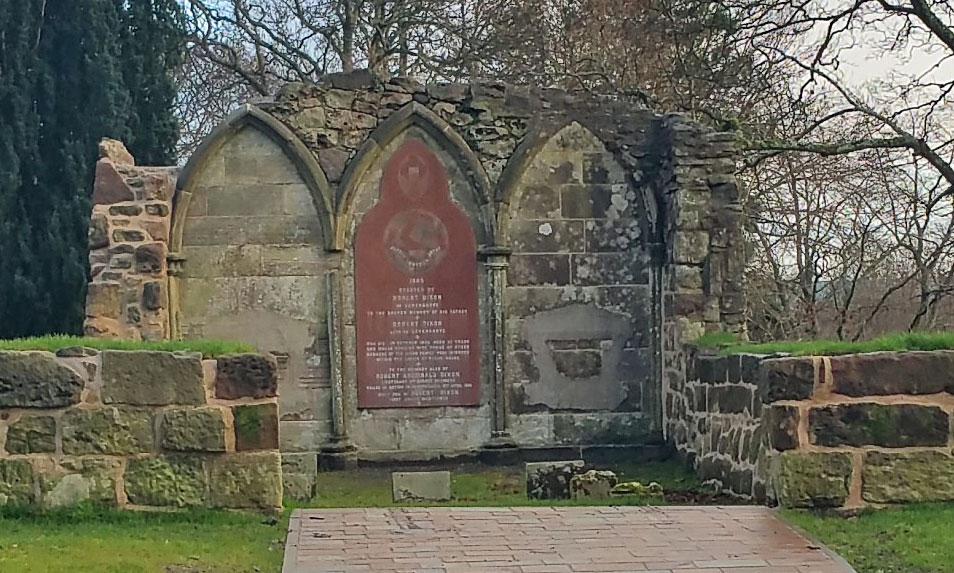 St Serf's Church is a medieval structure that underwent extensive alterations during the 19th Century. The church is a Scheduled Monument and important feature within the park, which demonstrates the historic nature of the area.
St Serf's Church is a medieval structure that underwent extensive alterations during the 19th Century. The church is a Scheduled Monument and important feature within the park, which demonstrates the historic nature of the area.
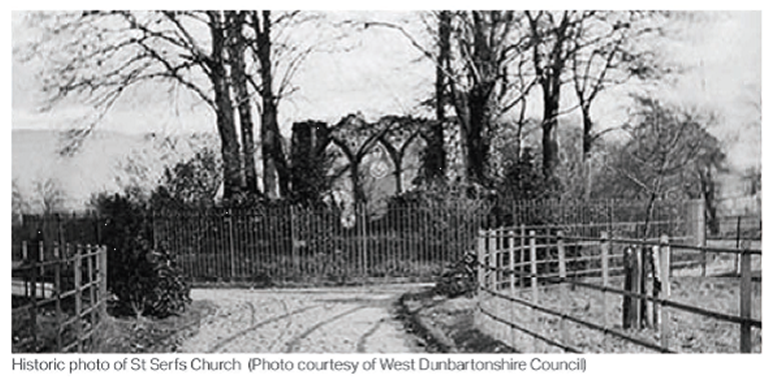
History
1200 - 1400
The church was first mentioned in the charter of 1226 as the Parish Church of Cardross. The extensive Parish of Cardross should not be confused with the village of Cardross, approx 5km for Dumbarton.
The church rose in prominence in the 14th Century when it was associated with Robert I (Robert the Bruce), whilst he lived (and died) at his manor, probably Leven, just outside of Dumbarton. This connection has given rise to a belief that the viscera (internal organs) of Robert I were buried at St Serf's in 1329 after his embalming. There is a plaque detailing this event on the northern side of the ruined church.
1600's
St Serf's remained the Parish Church of Cardross until about 1644 when the parish boundaries were redrawn and a new church erected in the village of Cardross (subsequently replaced on the same site in 1867). St Serf's, together with it's tiny clachan, then gradually fell into ruin. In Blau's Atlas of Scotland if 1654, the site is shown as 'Little Kirktoun' (of Cardross).
1800's
In 1805, when the lands of what is now Levengrove Park were acquired by John Dixon, the ruined church was adopted as the family burial ground. There are still Dixon family gravestones and large stone memorial plaques within the ruined church walls.
The Dixon family, who were prominent owners of Dumbarton Glassworks (1777 - 1850), built Levengrove House (demolished about 1880) and developed the grounds, which now make up much of the existing park.
1900 - 2018
The ruins were previously enclosed by a chain link fence on a small knoll within Levengrove Park. The area within the fence contained a number of trees that blocked out much of the sunlight.
Restoration Process
St Serf's Church was selected as a key area for restoration. The repair works were funded by an Ancient Monument Grant and included;
- removing the chain link fence
- removing trees and vegetation which were damaging the structure
- removing and replacing well-meaning but inappropriate modern repairs, where possible; and
- adding a new low seating wall around the church.
The work has helped secure the future of this important monument and has allowed it's story to be told.
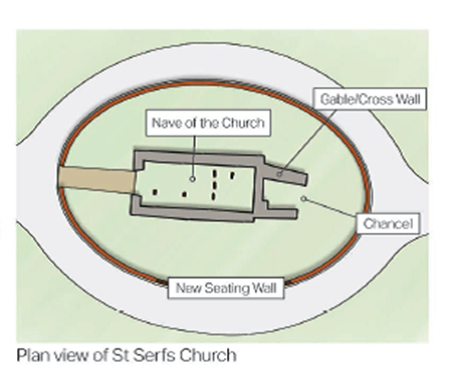
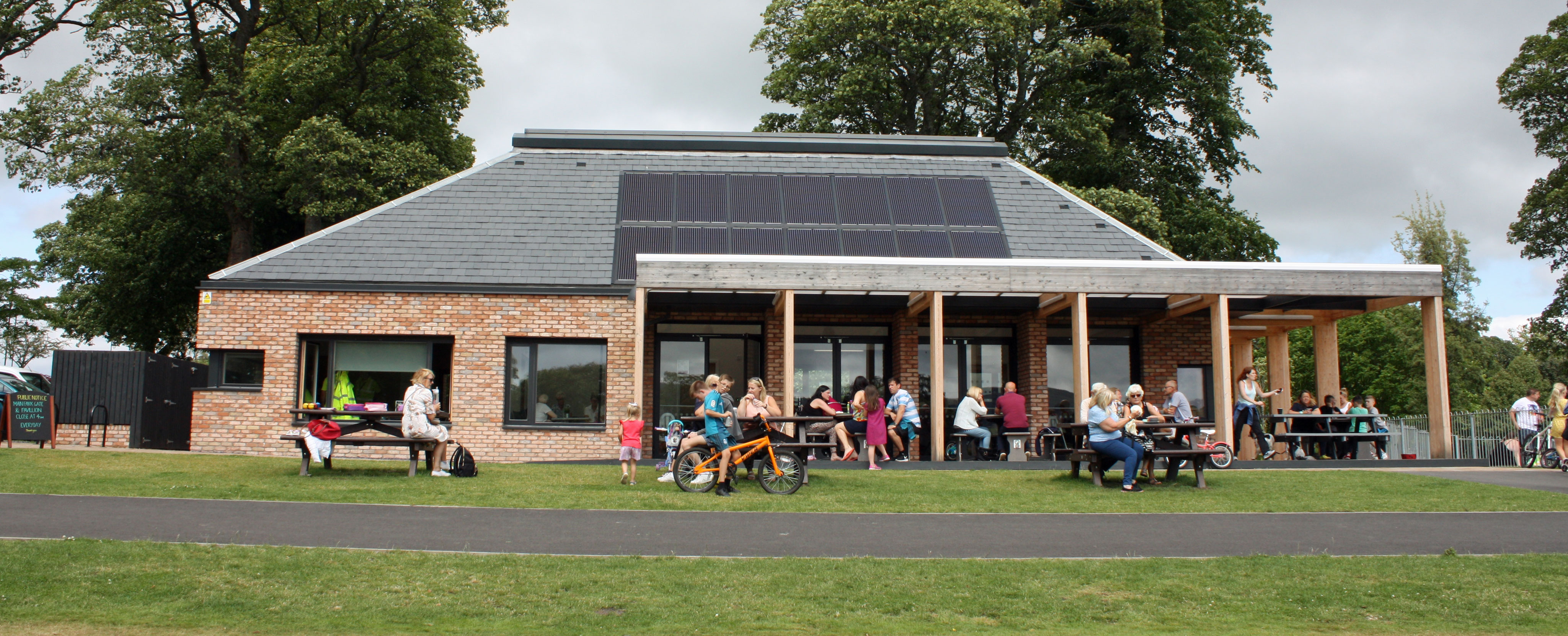
Areas of wildflower meadow planting have been incorporated into the park to help improve the local biodiversity. See if you can spot any of the wildflowers listed below and lookout for the insects which feed on the flowers.
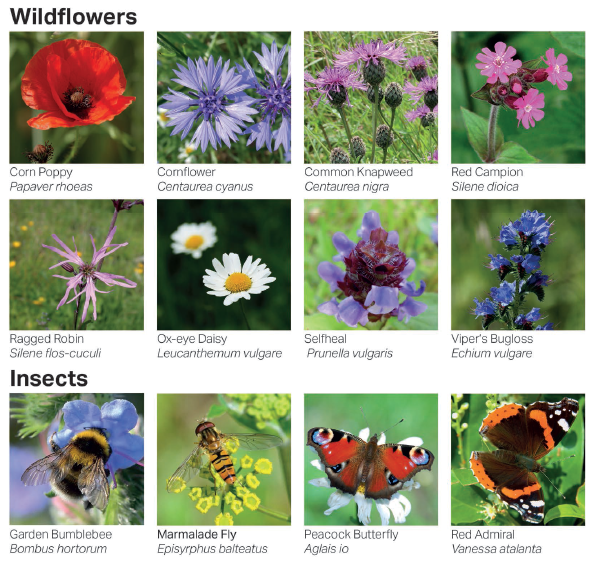
Wildflower Meadow Habitats
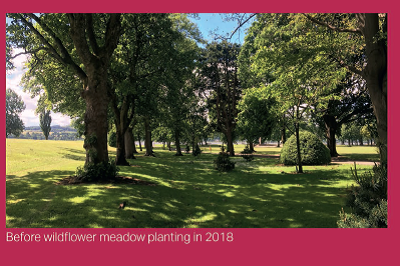 Wildflower meadows are an important type of lowland grassland. They contain abundant and diverse wild flowers and grasses, providing habitat and food for Butterflies, Bees, Birds and small Mammals.
Wildflower meadows are an important type of lowland grassland. They contain abundant and diverse wild flowers and grasses, providing habitat and food for Butterflies, Bees, Birds and small Mammals.
Wildflower meadows were once common across the lowlands of Britain, and were often maintained by traditional hay-making methods. However, it has been estimated that 97% of wildflower meadows have been lost since the Second World War, largely because of the change to more intensive farming methods, but also to forestry, urban growth and neglect.
Planting wildflower meadows within urban areas has become popular and provides may benefits, including colourful flowering displays and increased biodiversity.
The meadows flower during the summer months from June to September. Wildflower meadows are managed and maintained by cutting once or twice a year, similar to the way that hay meadows were managed in the past.
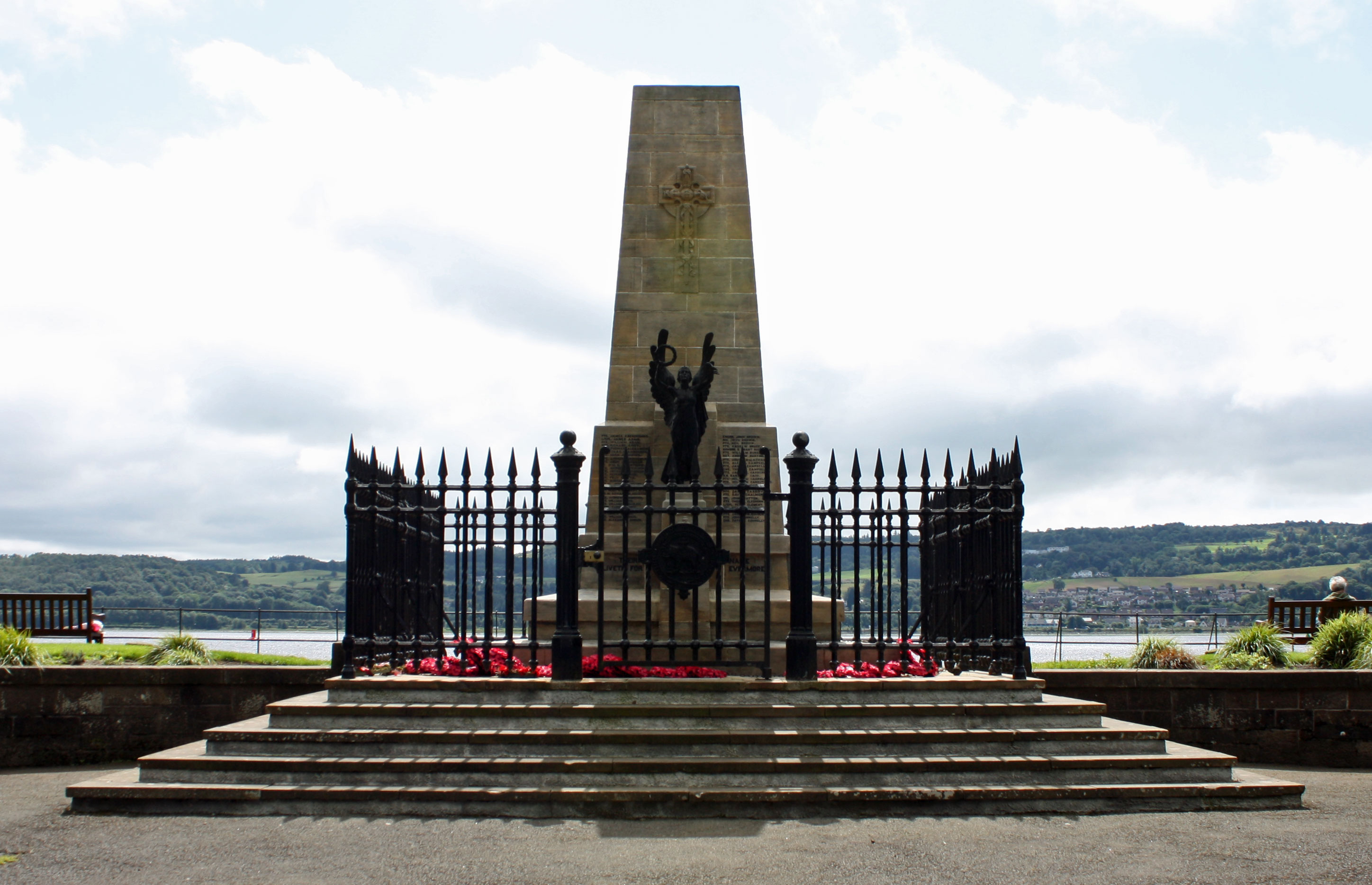 The Dumbarton War Memorial was unveiled on 1 October 1922 to honour and record the names of the residents of Dumbarton who were lost during World War One. The names of soldiers lost during later conflicts have been subsequently added to the memorial.
The Dumbarton War Memorial was unveiled on 1 October 1922 to honour and record the names of the residents of Dumbarton who were lost during World War One. The names of soldiers lost during later conflicts have been subsequently added to the memorial.
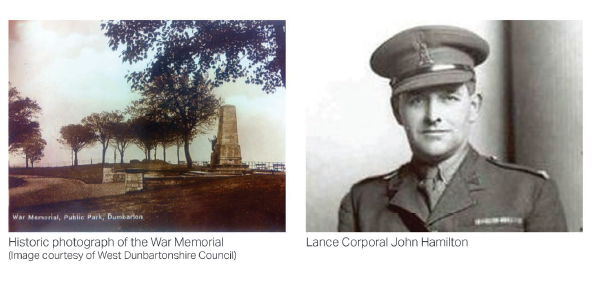
History
Dumbarton War Memorial was designed by Sir John Burnet, Son and Dick Architects, with contributions from Thomas Harold Hughes.
The architectural practice was started in 1919 and ended in 1921, being known as John Burnet, Son and Partners whilst Hughes was part of the practice. Hughes was taken on primarily to design war memorials, completing the Levengrove Park example and one at Wellington UF Church in Glasgow. The practice was short lived, completing only eight projects.
The memorial is a squat obelisk sat on a raised, rectangular plinth above a stepped base. The memorial is set within a cast-iron railed enclosure with curved low quadrant wall constructed of stugged and snecked ashlar. The walls end in square terminal piers with the obelisk itself constructed in wide and narrow banded ashlar. A bronze winged Victory figure is located against the north face of the obelisk.
The war memorial was designated a Category C listed structure in 1984.
In September 2017 a commemorative Victoria Cross plaque was added to the memorial to honour the centenary of Lance Corporal John Brown Hamilton earning a Victoria Cross for his actions during the battle of Passchendaele in the First World War.
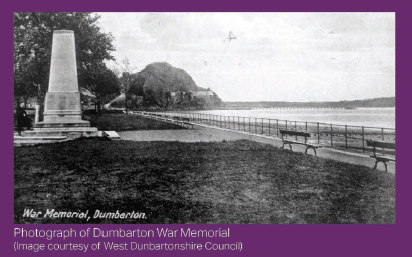
Restoration Process
The war memorial has been refurbished by:
- cleaning of the stone work and repointing;
- minor repairs to damaged lettering;
- installation of new locks on gates to replace the chain and padlocks; and
- the Friends of Levengrove have improved the setting of the War Memorial with new planting beds and a memorial bench which was donated by the West Dunbartonshire and Argyll Somme Association.